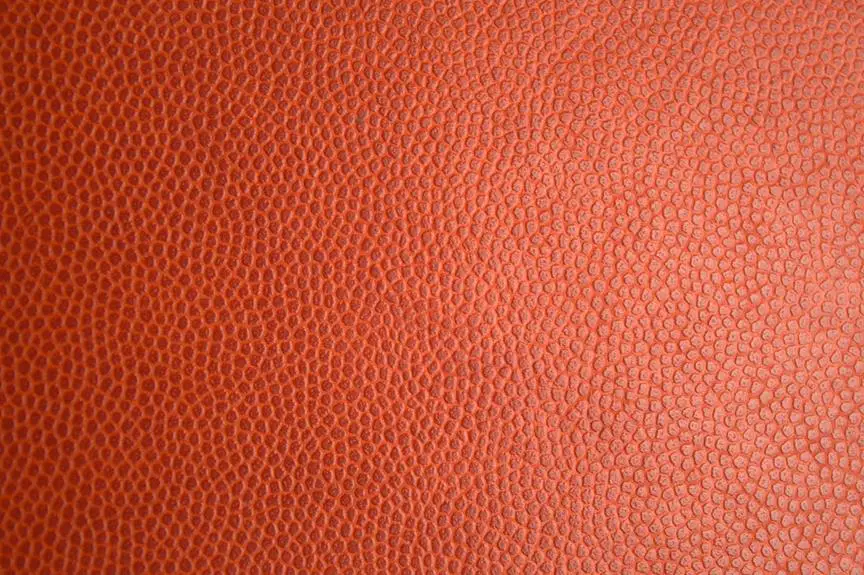So, you've heard about PU leather, but do you really know what it's all about? This artificial leather alternative has been gaining attention for its impressive qualities and versatility. From its origins to its comparison with genuine leather, there's a lot to uncover.
Let's delve into the fabric's qualities and explore its durability, environmental impact, care, maintenance, and various applications. By the end, you'll have a comprehensive understanding of PU leather and its advantages and disadvantages.
Get ready to master the ins and outs of this fascinating material!
Key Takeaways
- PU leather is a synthetic alternative to traditional leather, created by coating a base material with a layer of polyurethane.
- It is more affordable and easier to maintain than genuine leather, making it a versatile alternative for various applications.
- PU leather mimics the look of real leather at a more affordable price point, providing a cost-effective and sustainable alternative without sacrificing style.
- While PU leather has advantages such as cost efficiency and a wide range of colors and finishes, it also has disadvantages such as limited breathability and durability over time, as well as environmental concerns.
The Origins of PU Leather
PU leather, also known as polyurethane leather, originated in the mid-20th century as a synthetic alternative to traditional leather. Unlike genuine leather, which comes from animal hide, PU leather is a synthetic material created through a manufacturing process that involves coating a base material such as cotton or polyester with a layer of polyurethane. This process gives PU leather its unique properties, making it a popular choice for various products.
The manufacturing process begins with the base material, which is then coated with polyurethane to create the desired texture and appearance. This synthetic material offers several advantages over traditional leather, including enhanced durability, resistance to fading, and the ability to be easily cleaned. Additionally, PU leather is more affordable and doesn't require the same level of maintenance as genuine leather.
Understanding the origins and manufacturing process of PU leather provides insight into its qualities and benefits. As a synthetic material, PU leather has become a versatile alternative for various applications, from fashion and upholstery to accessories and automotive interiors. Its ability to mimic the look and feel of genuine leather while offering unique advantages has made it a popular choice in the modern market.
PU Leather Vs. Genuine Leather
When choosing between PU leather and genuine leather, you'll notice a significant difference in price and maintenance requirements.
- Comparison: Genuine leather is known for its durability and luxurious feel, while PU leather often mimics the look of real leather at a more affordable price point.
- Cost: Genuine leather tends to be more expensive due to the quality and craftsmanship involved in its production, whereas PU leather offers a budget-friendly alternative without compromising style.
- Sustainability: Genuine leather, although long-lasting, raises concerns about animal welfare and environmental impact, while PU leather, being synthetic, addresses these concerns to some extent.
It's essential to weigh the pros and cons when considering these two options. Genuine leather may require more care and investment, but it offers unparalleled quality and longevity. On the other hand, PU leather provides a cost-effective and sustainable alternative without sacrificing style. Understanding the differences in quality, cost, and sustainability will help you make an informed decision based on your preferences and values.
Durability and Longevity of PU Leather
PU leather is known for its durability and long lifespan, making it a practical and economical choice for many consumers. Its ability to withstand wear and tear over time, as well as its resilience to damage, sets it apart as a reliable material for various applications.
Understanding the factors that contribute to PU leather's longevity can help you make informed decisions when considering it for your next purchase.
PU Leather Lifespan
You can expect PU leather to have a lifespan of approximately 5-10 years with proper care and maintenance. PU leather's longevity is influenced by various factors such as maintenance, quality, and sustainability.
To ensure the durability and longevity of your PU leather items, consider the following:
- Regularly clean and condition your PU leather to prevent drying and cracking.
- Keep your PU leather items away from direct sunlight and heat sources to avoid fading and deterioration.
- Handle your PU leather products with care, avoiding sharp objects and excessive friction to maintain their pristine condition.
Wear and Tear
To understand the wear and tear of PU leather and its impact on durability and longevity, it's important to consider how regular use and maintenance practices contribute to the material's overall resilience. Proper care and maintenance can significantly affect the lifespan and durability of PU leather, ultimately impacting maintenance costs. Here's a comparison between the durability and maintenance costs of PU leather vs. genuine leather:
| Durability | Maintenance Costs | |
|---|---|---|
| PU Leather | Less durable | Lower |
| Genuine Leather | More durable | Higher |
While PU leather may be less durable compared to genuine leather, it requires lower maintenance costs. Understanding these factors can help you make an informed decision based on your specific needs and priorities.
Resilience to Damage
When caring for PU leather, you can enhance its resilience to damage by implementing regular maintenance practices. Proper maintenance not only prolongs the lifespan of PU leather but also helps it maintain its resistance to wear and tear.
Here are three essential maintenance practices to ensure the durability and longevity of PU leather:
- Regularly clean the surface with a damp cloth to remove dirt and prevent it from settling into the material.
- Condition the leather with a specialized PU leather conditioner to keep it soft, supple, and resistant to cracking or peeling.
- Keep the leather away from direct sunlight and heat sources to prevent fading and drying out.
Environmental Impact of PU Leather
Understanding the environmental impact of PU leather is crucial for making informed choices about your purchases.
PU leather, while offering a more affordable and durable alternative to genuine leather, raises concerns about its environmental impact. The production of PU leather involves the use of chemicals and petroleum-based materials, contributing to air and water pollution. Additionally, the disposal of PU leather products can release harmful toxins into the environment.
As a consumer conscious of the environmental impact of your choices, it's essential to consider sustainable alternatives to PU leather. You can explore options such as natural and recycled materials, or seek out products from companies committed to ethical and eco-friendly practices.
By supporting sustainable alternatives, you can reduce the demand for PU leather and minimize its environmental impact. Making informed decisions about the products you purchase not only benefits the environment but also encourages the industry to prioritize sustainability.
Your choices can contribute to a more eco-conscious and responsible approach to leather and fabric production.
Care and Maintenance of PU Leather
To maintain PU leather, regularly wipe it clean with a damp cloth and mild soap, avoiding abrasive cleaners or harsh chemicals. This simple routine will help preserve the material and extend its lifespan.
In addition to cleaning tips, proper storage is essential for maintaining the quality of PU leather. Here are some storage solutions to keep in mind:
- Keep PU leather items away from direct sunlight and heat to prevent fading and drying out.
- Use a breathable fabric or cover to protect PU leather furniture from dust and dirt buildup.
- Avoid placing heavy items on PU leather surfaces for an extended period to prevent indentations or creases.
Applications of PU Leather
You can find PU leather used in a wide range of applications, from fashion accessories and upholstery to electronic cases and automotive interiors. PU leather's versatility makes it a popular choice in various industries. Here are some common applications of PU leather:
| Application | Description |
|---|---|
| Fashion Industry | PU leather is commonly used in the fashion industry for making shoes, belts, and wallets. Its durability and wide range of colors make it a preferred material for many designers. |
| Automotive Interiors | Many car manufacturers use PU leather for car seats, steering wheel covers, and interior paneling. The material's ability to mimic genuine leather and its easy maintenance make it an ideal choice for automotive interiors. |
| Upholstery | Furniture manufacturers often use PU leather for upholstery due to its cost-effectiveness and ease of cleaning. It is commonly found in sofas, chairs, and ottomans. |
| Handbags | PU leather is a popular choice for making handbags and purses. Its ability to replicate the look and feel of real leather at a more affordable price point makes it a favorite among handbag designers. |
These applications demonstrate the widespread use and practicality of PU leather across various industries.
Advantages and Disadvantages of PU Leather
PU leather offers several advantages and disadvantages that should be considered when choosing it for various applications.
- Cost efficiency: PU leather is more affordable than genuine leather, making it an attractive option for those on a budget. This advantage allows you to achieve the look and feel of leather without breaking the bank.
- Ethical concerns: For those concerned about animal welfare, PU leather provides a cruelty-free alternative to genuine leather. By opting for PU leather, you can enjoy the appearance of leather while aligning with your ethical values.
- Versatility and breathability: PU leather is highly versatile, allowing it to be used in a wide range of products, from clothing to furniture. However, it's important to note that while PU leather is breathable, it may not offer the same level of breathability as genuine leather, which could be a disadvantage in certain applications.
Considering these advantages and disadvantages will help you make an informed decision about whether PU leather is the right choice for your specific needs.
Frequently Asked Questions
Can PU Leather Be Recycled or RePUrposed?
You can recycle PU leather through specialized processes, like chemical breakdown or mechanical reprocessing. Repurposing options are also available, such as creating new products or using it as a raw material in other industries.
What Are the Different Types of PU Leather and Their Unique Qualities?
When exploring the different types of PU leather, consider the finishes like grain, embossed, or metallic. Each offers unique qualities in terms of durability and maintenance. Understanding these variations allows you to make informed choices.
Is PU Leather Suitable for Use in Outdoor or High-Traffic Environments?
For outdoor durability, PU leather can be suitable, but it requires regular maintenance. Its ability to withstand high-traffic environments depends on quality. Consider sealing or treating it for extra protection. Proper care is key.
Are There Any Potential Health Risks Associated With Using PU Leather?
Potential health risks associated with PU leather can arise from the chemicals used in production. Be mindful of environmental impact and ensure proper ventilation. Researching and opting for high-quality, eco-friendly options can mitigate these concerns.
How Does the Cost of PU Leather Compare to Other Types of Leather?
When comparing prices, PU leather is generally more affordable than genuine leather. However, the quality comparison shows that genuine leather is more durable and has a higher perceived value.
- Tetron Fabric for Marine Applications: Durability and Use Cases - June 18, 2025
- Tetron Fabric for Outdoor Furniture: Weather Resistance and Care - June 18, 2025
- Tetron Fabric for Wall Coverings: Style and Application Tips - June 18, 2025



